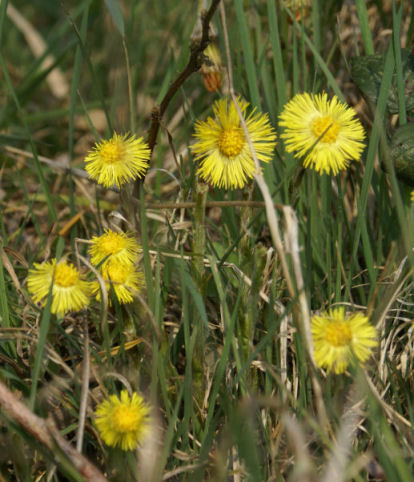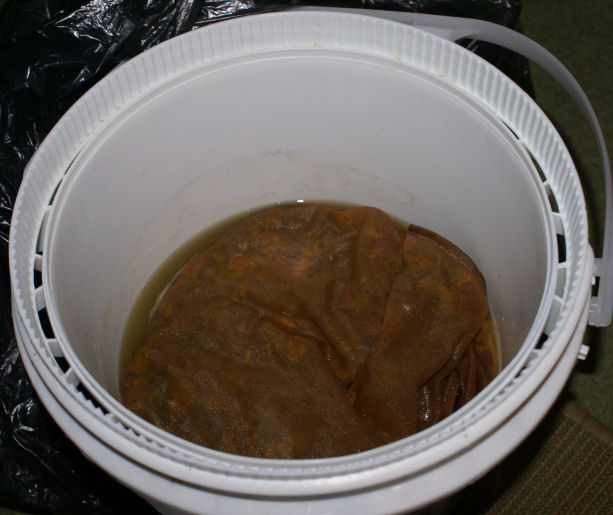The Wine-Maker's Calendar April
Written by Cab
The weather's warming up, it's time to get out there and do some gathering...
April is when the winemaking year really kicks
off. Spring brings wild flowers, greens, the first herb gluts of the
year, the peak of the early rhubarb, and of course you've still got
plenty of dried wines you can be making. It's pretty nearly your last
chance to put on something to be ready for autumn, and with that in
mind I tend to make a batch of metheglin around now.
But for me the greatest treat for April is flower wines; I love
foraging by lakes and ponds for the first watermint and coltsfoot, two
of the best ingredients for wine making in the whole year. In fact,
April is probably typified more by flower wines than by any others.
Coltsfoot Metheglin
5 cups coltsfoot flowers, loosely packed
3lb honey
1 teaspoon yeast nutrient
1 teaspoon citric acid
1 teabag
Water to about a gallon
champagne yeast

Possibly the best wine you will ever make. Seriously. A good batch of this is simply sublime.
Gather the coltsfoot flowers on a dry day. Yes, I know, so many
wild food recipes start that way, but this time it matters. Pack them
down lightly, err on having slightly more rather than slightly less.
When you get them home, pick off most of the stems, you don't want
many green bits, and put the flowers into a straining bag. Pour all the
honey out into a big pan, pour on the water, add the yeast nutrient and
citric acid, and bring to a low boil. Skim off all the scum as it
rises, and expect to take about an hour getting it all off. Add the
teabag, give it a minute, take it out again.
Put the flowers into a sterilised bucket, and pour your honeyish
hot water on. Allow to cool, and add the yeast, and four days later
take the bag of flowers out. Proceed as normal for any homebrew wine.
This one is sometimes ready very, very early. Sometimes its even
very good by midsummer. But at the moment, mine is in a bucket, look!

Dandelion Wine
6 pints dandelion flowers
3lb sugar
1 orange
2 lemons
1 little tin white grape concentrate
1 cup strong tea
wine yeast

Not the best wine, but one that is definitely worth a bash. Tasty
when well matured. Apparently it is traditional to look for dandelions
on St. Georges day (thats April 23rd, my non-English friends), but
personally I'm too busy hunting for St. Georges mushrooms on that day.
Gather all the flowers and use them fresh. Get rid of as much stalk as you can.
Pack them into a nylon straining bag.
Boul the sugar in the water, along with zest and juice from the
lemon and orange, grape concentrate, and tea. When its good and hot,
pour it in to the bucket. Add yeast when its cool, and ferment out as
normal.
Dandelion Wine (Kinnopio's Recipe)
I'm sure there are a million and one dandelion wine recipes out
there. Here is a C.J.J.Berry one which ends up quite sweet and (I
think) could pass as a pudding wine:
2 litres freshly picked dandelions with majority of greenbits removed
1.5kg sugar
4 oranges
4.5 litres water
Yeast and nutrient
Boil water and pour over flowers, allow to steep for two days in a
covered container. Boil for ten minutes with the orange zest. Strain
through wine bag/muslin into the sugar and allow to cool. Add juice
with yeast and nutrient, put in a demijohn with airlock. Ferment, rack
and then bottle. Should be ready by Christmas, though mine was fine in
October time. I have been told dandelion wine improves with age but
only have one bottle left so I haven't cracked it open yet.
Rhubarb Wine
There are so many variations on rhubarb wine, but heres a basic one
for you to faff about with. Change it, abuse it, but don't worry about
it, it'll work.
3lb rhubarb
3lb sugar
1 teaspoon yeast nutrient
wine yeast
De-leaf and chop the rhubarb, and put it in a straining bag in a
sterile bucket. Boil the sugar and yeast nutrient, pour it on top...
you kow the rest.
Now on to those variations... Some people prefer to add apples to
this (1 to 2lb of apples with 2lb of rhubarb). Some others like to make
this with honey instead of sugar. Some like to add a vanilla pod to the
water when they boil it. It certainly benefits from a little tannin
(from black tea, of course), but it certainly doesn't need any extra acid.
Cab's Infamous Japanese Knotweed Wine
Yes, you can. Really.
3lb japanese knotweed (read below carefully)
3lb sugar
Juice of half a lemon
1 cup strong tea
1 teaspoon yeast nutrient
champagne yeast
Gather your knotweed (remember, it is evil) when it is short, like
about half a foot to a foot high. Chop it on site. Thats because it is
eevil. Almost all of it is meristematic, a long word that means that if
you drop any of the stem, nearly anywhere, it can sprout. Thats why
transporting it is illegal, so don't. Remember, its eeevil. Do not, I repeat do not try to compost any. Really. Don't. This plant covers half of one percent of Britain, don't give it your garden too.
So, chop it on site. Put it in your straining bag when you get home,
and into the bucket. Boil up the rest of the ingredients (except the
yeast) and pour on top. Ferment out as normal.
Goes a funny colour, and it can even remain kind of pinky in the
finished bottle if you don't stabilise it with a campden tablet. Its
kind of like a cross between rhubarb wine and chardonnay; some people
hate it, some love it. You won't know which you are till you make some.
Watermint Wine
Or, for that matter, any kind of mint.
4-5 cups of mint, lightly packed.
3lb sugar
1 teaspoon citric acid
1 cup black tea
wine yeast (champagne yeast is good here, not necessary, but good)
Follow the standard herb wine recipe (boil stuff together, pour on
to the herbs in a straining bag). This wine comes out sweet, and don't
be afraid to add extra sugar during fermentation to make it sweeter, if
its going dry on you. It SHOULD be sweet. Serve it chilled ice cold on
a hot summer afternoon.
Watermint makes a phenomenally good herb wine. Apple mint is good. Spearmint wine tastes oddly of chewing gum.
So, there you go. Get out there and get on with it. Feel free to raise any questions on our fora. |